Trip to Calakmul
by Mari Pintkowski (February 2013)
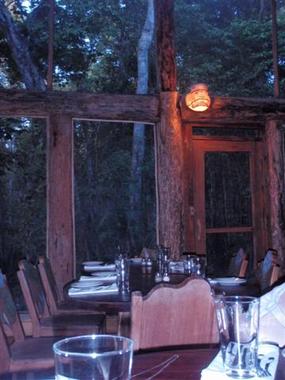
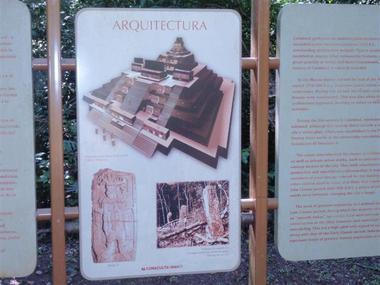
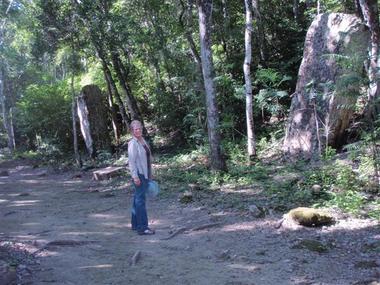
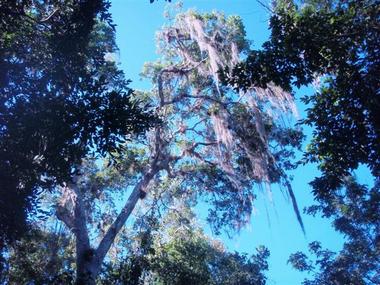
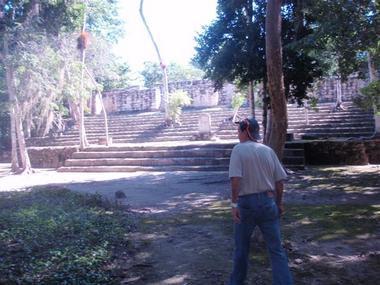
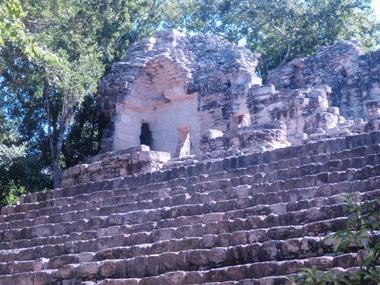
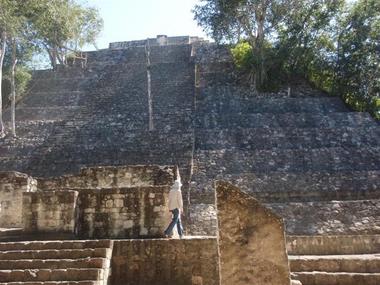
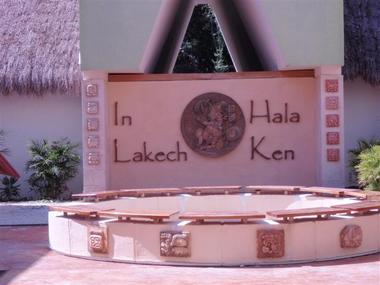
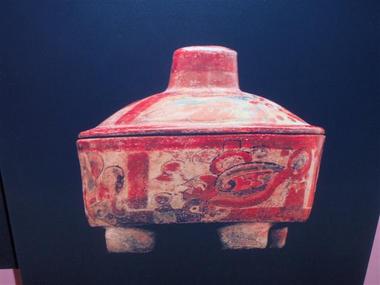
Being a well-informed traveler can turn a journey from a mediocre day trip to an experience of a lifetime.
I recently took a hastily planned road trip with my husband from La Selva Mariposa, our Bed and Breakfast in Tulum. We traveled 200 miles south to the hidden Maya ruins of Calakmul.
We researched Hotel Puerta Calakmul, and not only read their website, but also a review on Sac-Be.com. We received confirmation with directions that we carelessly left behind on the office desk. Since we had read about the ruin site a few years ago, we did not take the time to search the Internet in detail again. We figured we could do this when we got to our hotel. I grabbed an older copy of Michelin's Green Guide and a few snacks, and we rolled out of our driveway and headed south. The long drive gave us a chance to connect with each other and let memory, that slow lure of the past, remind us why these trips are so important.
A half-hour later, I opened the travel guide to Maya ruins in the state of Campeche and to our surprise, Calakmul was not listed, nor was it on the AAA map of Mexico that we carry in our car. We had driven the road from Escárcega to Chetumal before, and kind-of-sorta knew where Calakmul was located.
We stopped to get gas in Xpujil and the young woman at the register did not know where or how far the ruins of Calakmul were. Within a half hour, we entered into the Biosphere Reserve of Calakmul. It was then that we realized just how small the world is to people in these remote villages.
Our concern at this time became to find Hotel Puerta Calakmul before dark. We just assumed there would be information about the ruins and available tours in the area. Our confirmation letter said we needed to reserve a guide 24 hours in advance and, because we made the reservation at the last minute, this window had already passed. We knew we had to take our chances.
We did find the hotel just as the day was darkening. The room we reserved with a king bed was no longer available. The receptionist took us to room #1, the cabana closest to the reception area. The room was delightfully rustic and the hotel, at first glance, had everything we would need for a comfortable jungle stay. It did not take us long to realize that there was no one present to tell us about the nearby ruins, including guide information. We concluded that we would be going into the next day's journey blind, as we had done so many times when we were young travelers.
We chatted with others who were checking in and only found two young men who had visited the site that day. Ten of the 15 rooms were rented for the night and apparently everyone would be following us the next morning. The young travelers told us about the one-hour drive to the ruins and their adequate self-guided tour. They even told us about seeing a puma crossing the road not far from the hotel.
As we pulled out of the hotel entrance road the next morning and onto the unpaved road leading to the Calakmul ruins, we were stopped by two young Mexicans whose gold-encrusted teeth sparkled in the morning sun. They requested 102 pesos (almost $10) to enter. We had forgotten that the hotel reservation letter we received said it would cost $2 to $3 a person. He showed us a chart of the payment amounts and we handed over the pesos. The 20 km road was in good condition and I kept my eyes peeled for wildlife until we reached another check point. A short, dark-haired man with a serious expression approached the car and asked us for 108 pesos for the next 42 km; apparently the first payment was to an individual land owner whose property we had to pass through. We noted a sign to a museum at the second pay stop, but decided to stop there on our way out. It would have been a better choice for us to tour the museum before the ruins and inquire about an English-speaking guide at that point, but we were not informed about our options and did not think to ask questions of the money collectors. The road was well maintained and easy to navigate. I let Lou know that I was disappointed to have not seen even one monkey or toucan on our drive to the ruins.
My husband and I were among the first to pay the 46 pesos each to enter Calakmul ruins at 7:45 a.m. We entered alone and strolled along the paths toward the first structures as the morning light shimmered through the trees and made patterns on the jungle floor. We wove in and out of the different groupings, reading the signs telling about the significance of each ruin. The two other couples who arrived at Calakmul just after us seemed to appear and disappear as we chose different paths to maneuver around the ancient site.
We were beginning to understand why UNESCO had identified this as a World Heritage Site. This distinction would preserve and protect it for the benefit of all humanity now and in the future.
As we read on, we found out that Calakmul was the most important urban center in the southern part of Campeche as well as one of the most outstanding cities of the Mayan Classic Period (500–900 AD). A regional coalition was formed with a number of smaller sites in the area that were constantly engaging in conflicts with their southern neighbors, Tikal in particular.
Like most Maya cities in the southern lowlands, Calakmul began its decline at the middle of the Classic Period. At that time, the city was reoriented politically and began to thrive once again. Some of the 120 stelas from as early as 300 AD, tell us that the activity at the Calakmul site during the Preclassic Period was mainly ceremonial in nature. The most recent stelas were carved in 909 AD.
Because the natural wonders that surrounded us were as intriguing as the ruins, we wandered the paths reading the signs and hoping to see perhaps a puma, jaguar, ocelot, and yet not come face to face with one of the snakes or crocodiles who call this place home. I have spent the last year studying trees in the Maya forest and was delighted to see a mahogany, cedar, chicozapote, rubber, zapote negro, nance, mamey, cirocote, and guaya tree.
The central urban area is over one square km. and is divided into five large areas around the plaza central. The small ball court on the north plaza of the Grand Acropolis had some reconstruction done, but had no hoop or markers remaining. Archeologists suspected that an earlier ball court existed. The Grand Acropolis, at the end of the Classic Period around 900 AD, included houses for the royal family, terrazas and public areas. The second-tallest building in this grouping has four platforms at the top. This includes a huge staircase which interacted with the living quarters on each level. You are able to see the different construction stages. A zoomorphic mask was found at the base of the stairs that dates to 431 AD, the earliest mention of a ruler.
Until we saw the rendering of the pyramids at the museum, we could not imagine that the main structures had stairs on all four sides. After seeing the Grand Acropolis, we looked at each other and wondered, "Is that all there is?" Other people drifted past us in the quiet morning. A few we stopped to talk to during our exploration of the site felt the same way. It was interesting, but not as massive as we were led to believe.
The early morning had turned into a beautiful day. We continued to wander farther along the paths, but often felt like we were going around in circles. The sounds of the howler monkeys in the trees gave it an eerie effect. At moments like this, we valued past ruin experiences when we had a guide to answer our questions and point out the most important details that are not listed on the signage in the site. Before long, we came to a larger grouping with a few workers taking a break at the bottom of an enormous structure, both in height and width. They told us that there was an even taller pyramid around the corner. This did not seem possible, but we proceeded to follow the paths and smiled at each other as we shaded our eyes and glanced up at the towering stone structure. At this point, we both agreed that this journey was well worth the distance we traveled.
We drove back to the museum and immersed ourselves in the story of the ancient Maya who inhabited Calakmul during the pre-Columbian era. Upon entering the museum, we discovered the significance of the jaguar to the Maya culture. This majestic animal was considered to be the "protector of fauna, who allowed or denied the hunt to humans. It is associated with fertility and the life energy that springs from the bowels of the earth."
Among other things the museum highlighted in photos, replicas and some original samples, the highly sophisticated ceramics that were produced in this city. We did discover that we could have hired a guide at the museum for a very reasonable price.
It was time to get back on the road as we had a long drive ahead of us. With each journey we make in this vast and unpredictable world, our spirits are nourished and we are honored to once again call Mexico our adopted home.
What we learned that we want to pass on to other travelers so that your experience here and other sites will be the best ever:
Read up on the sites before you arrive.
Bring a current travel guide or printed pages from the Internet or book.
In the more isolated locations, you cannot count on WiFi being available for you to research once you arrive at hour hotel.
Make sure you have your paper directions in your hand before your leave home. You may not even have phone service to retrieve them from your phone.
If you have a hotel confirmation, ask questions about tours and whether you will be able to get information when you arrive. Ask if there is someone on site at the hotel who is familiar with the area and can give you detailed information.
Ask if there are books and detailed tour information at the hotel.
